|
|
|
Sort Order |
|
|
|
Items / Page
|
|
|
|
|
|
|
| Srl | Item |
| 1 |
ID:
148153
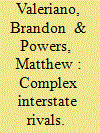

|
|
|
|
|
| Summary/Abstract |
The goal of this article is to engage the concept of rivalry, analyze its possible deficiencies, and empirically identify which groups of states make up what we call complex rivals. A complex rivalry is defined as a group of at least three states whose relationships are linked by common issues, alignments, or dispute joiner dynamics in which there is a threat of militarized conflict and includes persistent long-term interactions and collective animosity. Once the cases that make up complex rivals are described, we examine the dynamics of conflict within complex rivalries. We show that complex rivals tend to follow a different path to war when compared to dyadic rivals in that they experience more war on average, are more likely to include major powers, and fight predominately over positional as opposed to spatial concerns.
|
|
|
|
|
|
|
|
|
|
|
|
|
|
|
|
| 2 |
ID:
132317
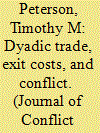

|
|
|
|
|
| Publication |
2014.
|
| Summary/Abstract |
Most studies of the link between dyadic trade and militarized conflict examine the extent of trade interaction. However, interaction measures do not account for the impact of cutting off trade (i.e., exit costs). In this article, I highlight the link between exit costs, the cost of conflict, and "the spoils of conquest," arguing that one state's exit costs are associated with higher incidence of dyadic conflict when its trade partner's exit costs are low. However, its exit costs become less aggravating-and eventually pacifying-as its trade partner's exit costs increase. I test this argument by estimating import demand and export supply elasticities, developing yearly exit cost measures for directed dyads, 1984-2000. Statistical tests confirm that unilaterally high exit costs are aggravating, but that jointly high exit costs are pacifying, a pattern most prominent for trade in strategic commodities.
|
|
|
|
|
|
|
|
|
|
|
|
|
|
|
|
| 3 |
ID:
070263
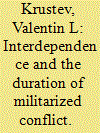

|
|
|
| 4 |
ID:
124521
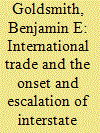

|
|
|
|
|
| Publication |
2013.
|
| Summary/Abstract |
Although study of the relationship between international trade and militarized conflict has become more sophisticated, whether trade reduces the chance of conflict, exacerbates it, or has no effect, remains contested. Integrating expectations from schools of thought often portrayed as incompatible, I consider two aspects of trade - volume and interdependence - and model conflict as a two-stage process involving onset and escalation. This perspective leads to robust statistical findings that trade is Janus-faced, both facilitating and inhibiting conflict at different stages, supporting the conclusion that a focus on international conflict as a communication process promises better theory in international relations.
|
|
|
|
|
|
|
|
|
|
|
|
|
|
|
|
| 5 |
ID:
099115
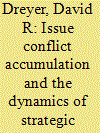

|
|
|
|
|
| Publication |
2010.
|
| Summary/Abstract |
Although states at times contend over a single issue (such as territory), international rivals often contend over multiple issues simultaneously. Issue conflicts tend to accumulate among rivals due to the development of enemy images of the "other," which causes states to view as threatening, behavior that was previously viewed as non-threatening. Once multiple issues are on the agenda, issues become linked as states begin to view the "other" as the main problem in settling all disagreements. Issue accumulation also increases the stakes of rivalry, which likely increases the probability that states will choose to bear the costs of engaging in militarized conflict seeking the settlement of issues in one's favor. An examination of strategic rivals supports the expectations that issue conflict accumulation tends to increase the likelihood of militarized disputes and war. The results also reveal that some paths of issue accumulation, in which certain types of issues come under contention, tend to be more dangerous than others.
|
|
|
|
|
|
|
|
|
|
|
|
|
|
|
|
| 6 |
ID:
100264
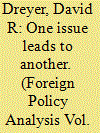

|
|
|
|
|
| Publication |
2010.
|
| Summary/Abstract |
Rather than competition over one issue or another (such as territory or status) leading to war, in this study it is argued that war is often likely the result of an issue spiral-a dynamic process in which tension increases as multiple issues accumulate. Once an initial issue disagreement is established, the development of enemy images may cause states to view the "other's" behavior and intentions in relation to additional issues as threatening. States may subsequently seek to gain an advantage on a new issue in order to prevent one's competitor from doing so, or in order to gain leverage on other issues. A state's aggressive actions in relation to new issues tend to reinforce their rival's perceptions that the state has aggressive intentions in relation to earlier established disagreements, further increasing tension. Issue accumulation, furthermore, increases the stakes of competition, which increases the likelihood that states will be willing to bear the costs of war seeking favorable issue settlement. As tension heightens and the rationality of engaging in large-scale militarized conflict increases, a state may initiate war if a rival presses its demands on an issue fearing that failure to demonstrate resolve will lead one's competitor to press its demands on other issues as well. An examination of relations between China and Vietnam in the 1970s reveals that an issue spiral, in which one issue led to another and the accumulation of issues contributed to the deterioration of relations, precipitated the 1979 Sino-Vietnamese War.
|
|
|
|
|
|
|
|
|
|
|
|
|
|
|
|
| 7 |
ID:
140079
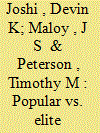

|
|
|
|
|
| Summary/Abstract |
Structural theories of international peace among democratic regimes have relied on two distinct explanatory logics: democratic institutions may cause a state’s foreign policy to tend toward peace by exposing policymaking elites to pressure from ordinary citizens (the popular logic) or to pressure from other governmental agencies (the elite logic). These logics are often conflated in scholarly studies of war and peace, but we attempt to isolate the popular logic for empirical testing by developing a novel measure of institutionalized popular influence, the Institutional Democracy Index (IDI). Whereas previous usage of the Polity index to operationalize democratic structures has succeeded in testing the elite logic more than the popular logic, we use the IDI to analyze long-established democracies’ involvement in international conflict between 1961 and 2001. What we find are significant differences within the family of democratic regimes that point to a monadic structural explanation of peace: more popular democracies are less warlike with respect to all other regimes, not just other democracies. By capturing variance among democratic regimes in their structures of inclusion (especially formal rules pertaining to voter access, electoral formulae, and cameral structures), the IDI enables us to observe crucial differences between the conflict propensities of more popular and more elite types of democracy.
|
|
|
|
|
|
|
|
|
|
|
|
|
|
|
|
| 8 |
ID:
052822
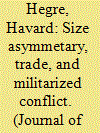

|
|
|
|
|
|
|
|